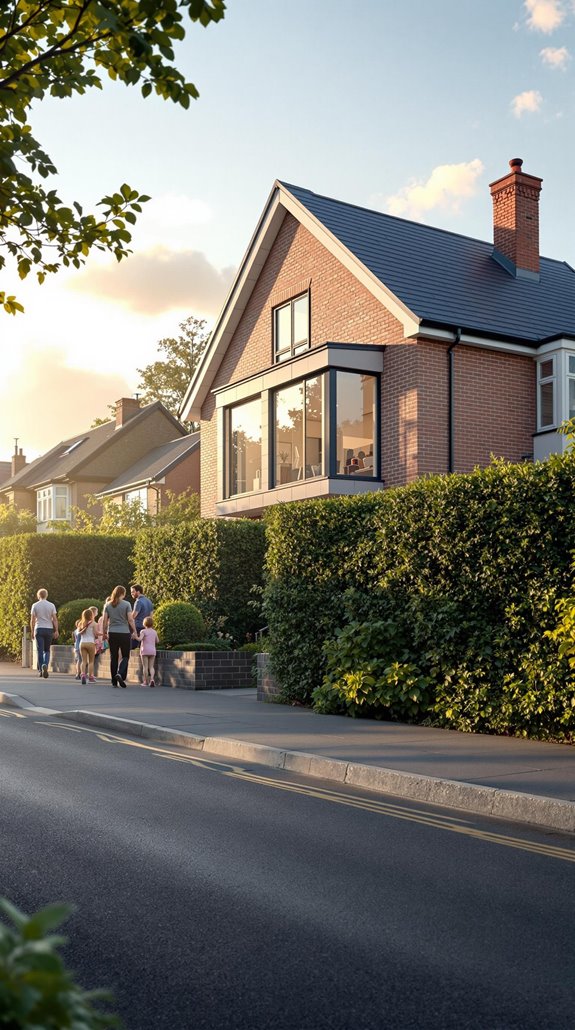I’ve seen countless property developers and homeowners devastated when their planning applications get rejected, often for reasons they never saw coming. The harsh reality is that local planning authorities refuse applications based on strict criteria that most people don’t fully understand until it’s too late. Whether you’re planning a simple extension or a major development, I’ll show you the exact reasons planning permission gets denied and how you can bulletproof your application before submitting it.
Key Takeaways
- Applications automatically fail when breaching the National Planning Policy Framework, conflicting with local development plans, or ignoring green belt restrictions.
- Design-related rejections occur when proposals ignore the National Design Guide, use inappropriate materials, or clash with local character and conservation areas.
- Neighbour amenity concerns like loss of light, privacy issues, and failure to maintain the 18-meter distance rule frequently cause refusals.
- Infrastructure capacity limitations, inadequate traffic impact assessments, and inability of local utilities to handle demand often derail planning applications.
- Technical documentation errors including missing floorplans, incorrect elevations, incomplete application forms, and inconsistent drawings trigger automatic rejections.
Policy and Legal Compliance Violations That Lead to Automatic Refusal
When local planning authorities review applications, they’ll automatically refuse proposals that breach fundamental policy frameworks. I’ve seen countless applications rejected because they violate the National Planning Policy Framework‘s core principles or conflict with local development plans.
You’ll face immediate refusal if your proposal ignores green belt restrictions, breaches conservation area protections, or contradicts heritage policies. Special protections exist in Green Belt and flood zone areas against overdevelopment. Planning officers won’t negotiate on these non-negotiables – they’re bound by law to protect these designations. Additionally, failing to consider environmental considerations can lead to significant issues during the application process.
Your application must align with sustainability mandates and biodiversity net gain requirements. I recommend thoroughly reviewing your local development plan and area-specific zoning regulations before submitting. These aren’t suggestions – they’re legal requirements that determine your application’s fate from day one.
Design Quality and Local Character Compatibility Issues
Beyond hard policy violations, design-related rejections represent the largest category of planning refusals I encounter in practice. Your proposal’s success hinges on demonstrating compatibility with local character and design standards.
I’ve seen countless applications fail because they ignore the National Design Guide or local design codes like Nunthorpe Grange Design Code. Using modern cladding in heritage zones or proposing oversized extensions that dwarf neighboring properties creates instant rejection triggers. To improve your chances of approval, consider incorporating energy-efficient solutions that align with contemporary design expectations.
Focus on proportionate scale, appropriate materials, and cohesive architectural styles that complement your streetscape. Avoid cramped layouts, substandard room sizes, or overdevelopment that eliminates green space. Study your area’s settlement patterns and building vernacular carefully.
Design quality isn’t subjective—it’s measurable against established frameworks that planners use consistently. When planning departments experience connection pool timeout issues with their database systems, applications may face processing delays that can complicate your submission timeline.
Neighbour Amenity Impact and Privacy Concerns

While your design might perfectly align with local character guidelines, neighbour amenity concerns often derail otherwise solid applications. I’ve seen countless projects rejected because they overlooked fundamental privacy and light requirements that protect existing residents.
Loss of light tops the refusal list. When your extension blocks sunlight to neighbouring properties, planning officers will likely refuse permission, even without formal objections. They’re protecting neighbours’ rights to direct daylight in their homes.
Overlooking concerns follow closely. If your development creates direct views into neighbours’ private spaces—especially rear gardens and habitable rooms—expect resistance. The standard 18-meter distance rule for facing windows isn’t negotiable. Privacy expectations vary significantly based on whether you’re dealing with terraced houses versus detached properties, as property type influences what neighbours can reasonably expect.
Room function matters significantly. Habitable rooms like bedrooms receive stronger protection than bathrooms or utility spaces, making accurate room identification essential for approval.
Environmental Protection and Ecological Considerations
Environmental considerations can sink your planning application faster than most design flaws, especially since councils now scrutinize ecological impacts more rigorously than ever before. I’ve seen countless applications rejected because developers overlooked protected species like badgers or failed to conduct proper ecological surveys. You’ll face automatic refusal if your proposal threatens SSSIs, ancient woodlands, or lacks biodiversity net-gain evidence. Additionally, neglecting to address early signs of damp can lead to significant issues that may complicate your application further.
Don’t underestimate EIA requirements—Schedule 2 developments need thorough environmental assessments covering pollution risks and long-term ecological effects. Your application must include detailed mitigation strategies and align with Environment Agency guidelines. Conducting environmental assessments and consulting experts can mitigate risks and prevent costly refusals. Flood risk assessments, sustainable drainage systems, and contamination management plans aren’t optional extras—they’re essential safeguards. Missing any of these components virtually guarantees rejection, so prioritize environmental compliance from day one.
Infrastructure Capacity and Transportation Constraints
Although design and environmental factors grab attention, infrastructure limitations kill more planning applications than developers realize. I’ve seen countless projects fail because local utilities can’t handle the demand. When you’re planning data centers or large developments, you’re competing with existing infrastructure that’s already stretched thin—just look at the recent Buckinghamshire and Hertfordshire data center refusals.
Your application needs bulletproof traffic impact assessments. Local authorities won’t approve projects that’ll clog their roads or overload their transport networks. You must demonstrate how you’ll handle increased vehicle movements without creating congestion nightmares.
The solution? Engage utility companies early, conduct thorough capacity assessments, and propose infrastructure upgrades if necessary. Don’t let inadequate sewage systems or overwhelmed electrical grids torpedo your carefully planned project. The current planning system’s complexity and uncertainty creates additional barriers that developers must navigate alongside these infrastructure challenges.
Community Opposition and Public Consultation Failures
Community opposition derails more planning applications than poor design or environmental concerns—it’s the silent killer that catches developers off guard. I’ve seen applications with 4,310 objection letters versus 487 support letters get refused, proving numbers matter. The statistics are stark: 13% of England’s planning applications were refused or withdrawn in 2021, often due to stakeholder communication breakdowns. Engaging with a knowledgeable estate agent can provide insights into local community sentiments that may influence your application.
You’ll face the toughest opposition in London and the East, where 12 out of 15 highest-refusal councils operate. Land scarcity intensifies community pressure there. Councils without political majorities show 60% higher refusal rates—they’re more responsive to community pressure.
Your consultation strategy determines success. Inadequate public engagement during pre-application phases triggers refusals. I’ve witnessed cases where councils cited insufficient community involvement as grounds for rejection, making thorough consultation non-negotiable. The most vocal opposition comes from wealthier commuter belt areas where established residents resist new housing developments.
Application Documentation Deficiencies and Technical Errors

While community opposition grabs headlines, technical documentation errors silently torpedo more planning applications than developers realize. I’ve seen countless applications rejected for missing floorplans, incorrect elevations, or drawings without proper scale indicators. These aren’t complex policy issues—they’re basic technical oversights that you can prevent.
Your application form must be complete in every section. Missing information or incorrect fees trigger automatic refusals. Guarantee your description matches your drawings exactly; inconsistencies raise red flags with planning officers.
Your drawings need floorplans showing existing and proposed layouts, elevations from all relevant angles, and site plans with clear boundaries. Include scale bars and north arrows on every drawing. Double-check that all drawings reflect the same proposed work consistently. Before submission, conduct thorough checks to ensure all required documents are included, as attention to detail is crucial for avoiding refusal. Additionally, be aware that structural surveys may be necessary if subsidence is suspected, as their findings can influence planning decisions.
Green Belt and Conservation Area Restrictions
When your development site falls within Green Belt or conservation areas, you’re entering planning’s most restrictive territory where standard approval strategies won’t work.
I’ll help you navigate these challenging waters by understanding what planners scrutinize most. In Green Belt zones, you must demonstrate “very special circumstances” that outweigh harm to openness and prevent urban sprawl. Economic benefits like job creation can justify exceptions, but only when no alternative sites exist outside protected zones. Engaging in a snagging survey before construction can help ensure compliance with local regulations and standards.
Conservation areas demand architectural harmony with existing streetscapes. Councils will reject designs that clash with local character—think mansard roofs in butterfly-roof neighborhoods. Your proposals must complement heritage assets while avoiding potential structural damage. Additionally, developments in these areas must avoid protected species habitats, as environmental concerns involving bats or other wildlife can lead to automatic refusal.
Success requires exceptional design quality, sustainability justification, and perfect alignment with local planning policies. Standard approaches guarantee refusal here.
Appeal Success Rates and Strategies to Avoid Rejection
Should you face planning permission refusal, understanding appeal success rates becomes your roadmap to overturning decisions. I’ll show you how to maximize your chances of success.
Written representations carry only 30% success rates, yet 92% of appellants choose this route. Don’t make this mistake. Hearings deliver 56% success, while inquiries achieve 65% – particularly effective for major developments.
Your strategy matters greatly. Appeals against officer-recommended refusals succeed 40% of the time, so securing officer support strengthens your position considerably. However, appeals against refusals where officers recommended approval succeed 65% of the time, demonstrating the significant impact of professional backing. The December 2024 NPPF revision boosted success rates by 8% for hearings and 4% for written procedures.
Choose your procedure wisely based on project complexity. Engage in pre-application discussions to address objections early. Align proposals with local policies, and monitor NPPF updates that continue improving appeal outcomes.
Conclusion
I’ve outlined the main pitfalls that’ll sink your planning application, but success comes down to preparation. Start with pre-application discussions to identify potential issues early. Review local policies thoroughly, engage with neighbors proactively, and guarantee your documentation’s complete. Don’t underestimate design quality—it matters more than you’d think. If you’re facing rejection, remember that appeals can work, but prevention’s always better than cure. Plan smart, avoid these traps.
References
- https://planning-by-design.co.uk/planning-permission-in-decline-a-growing-crisis-for-the-uks-housing-sector/
- https://www.placechangers.co.uk/blog/planning-consultations/do-objections-drive-planning-application-refusal/
- https://homz.uk/what-is-the-success-rate-of-the-retrospective-planning-application/
- https://www.gov.uk/government/statistics/planning-applications-in-england-january-to-march-2025/planning-applications-in-england-january-to-march-2025-statistical-release–2
- https://todaysconveyancer.co.uk/success-planning-application-appeals-falls-lowest-level-five-years/
- https://www.yooparchitects.co.uk/planning-permission/uk-planning-permission-applications-in-north-london-fail-for-these-3-reasons/
- https://resi.co.uk/advice/planning-permission/reasons-why-planning-permission-is-refused
- https://urbanistarchitecture.co.uk/planning-permission-refusal-top-10-reasons/
- https://www.localarchitectsdirect.co.uk/what-do-if-your-planning-application-rejected
- https://www.gov.uk/guidance/determining-a-planning-application

